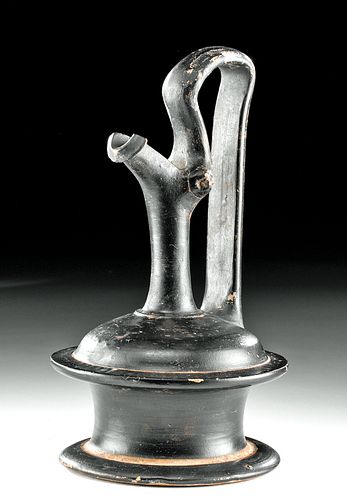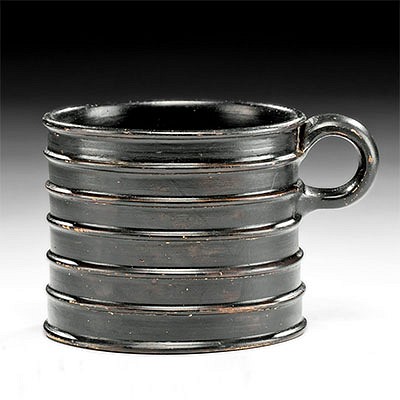Greek Gnathian Glazed Pottery Epichysis
Lot 39d
About Seller
Artemis Fine Arts
686 S Taylor Ave, Ste 106
Louisville, CO 80027
United States
Selling antiquities, ancient and ethnographic art online since 1993, Artemis Gallery specializes in Classical Antiquities (Egyptian, Greek, Roman, Near Eastern), Asian, Pre-Columbian, African / Tribal / Oceanographic art. Our extensive inventory includes pottery, stone, metal, wood, glass and textil...Read more
Categories
Estimate:
$600 - $900
Absentee vs Live bid
Two ways to bid:
- Leave a max absentee bid and the platform will bid on your behalf up to your maximum bid during the live auction.
- Bid live during the auction and your bids will be submitted real-time to the auctioneer.
Bid Increments
| Price | Bid Increment |
|---|---|
| $0 | $25 |
| $300 | $50 |
| $1,000 | $100 |
| $2,000 | $250 |
| $5,000 | $500 |
| $10,000 | $1,000 |
| $20,000 | $2,500 |
| $50,000 | $5,000 |
| $100,000 | $10,000 |
| $200,000 | $20,000 |
About Auction
By Artemis Fine Arts
Mar 12, 2020
Set Reminder
2020-03-12 10:00:00
2020-03-12 10:00:00
America/New_York
Bidsquare
Bidsquare : Ancient / Ethnographic Around The World
https://www.bidsquare.com/auctions/artemis-gallery/ancient-ethnographic-around-the-world-4957
Ancient art from Egypt, Greece, Italy and the Near East, as well as Asian, Fossils, Pre-Columbian, Native American, African / Tribal / Oceanic, Spanish Colonial, Russian Icons, Fine art, much more! Artemis Fine Arts info@artemisgallery.com
Ancient art from Egypt, Greece, Italy and the Near East, as well as Asian, Fossils, Pre-Columbian, Native American, African / Tribal / Oceanic, Spanish Colonial, Russian Icons, Fine art, much more! Artemis Fine Arts info@artemisgallery.com
- Lot Description
Magna Graecia, South Italic Colonies, Apulia, near Ignazia, Hellenistic period, ca. second half of the 4th century BCE. A fine wheel-thrown pottery pouring vessel known as an epichysis with a characteristic spool-shaped body. The flat-based vessel has a hemispherical shoulder, a cylindrical neck with an elongated pouring spout, a pair of protruding, stylized female maskettes on either side of the spout base, and a loop handle that arches high above the neck and shoulder. The black-glazed vessel still displays faint traces of its original fugitive pigment that formed vines and grape leaves on the shoulder, radiating frets around the upper protruding body lip, and circular motifs with grape clusters on the front of the body. Size: 3.9" W x 6.875" H (9.9 cm x 17.5 cm)
For a strikingly similar example with fantastic remains of fugitive pigment, please see The Metropolitan Museum of Art, accession number 1971.11.4.
Provenance: private J.H. collection, Beaverton, Oregon, USA, acquired in November 2018; ex-private Montrose, California, USA collection; ex-Lawrence Buchanan and Dr. Enrique von Kiguel collection, formed throughout the 1970s and 1980s
All items legal to buy/sell under U.S. Statute covering cultural patrimony Code 2600, CHAPTER 14, and are guaranteed to be as described or your money back.
A Certificate of Authenticity will accompany all winning bids.
We ship worldwide and handle all shipping in-house for your convenience.
#153903Repairs to areas of handle, with resurfacing and overpainting along beak lines. Nicks and abrasions to base, body, neck, spout, and handle, with extensive fading to original fugitive pigment, and minor darkening to areas of original, non-black pigment. Light earthen deposits throughout, and nice root marks beneath base. Traces of original fugitive pigment still visible in some areas.Condition
- Shipping Info
-
All shipping is handled in-house for your convenience. Your invoice from Artemis Gallery will include shipping calculation instructions. If in doubt, please inquire BEFORE bidding for estimated shipping costs for individual items.
-
- Buyer's Premium



 EUR
EUR CAD
CAD AUD
AUD GBP
GBP MXN
MXN HKD
HKD CNY
CNY MYR
MYR SEK
SEK SGD
SGD CHF
CHF THB
THB















